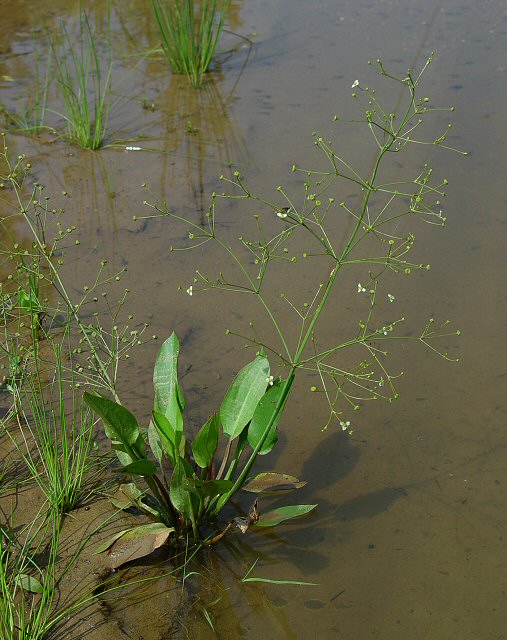Alisma triviale Pursh
Northern Water Plantain

Native
CC = 5
CW = -5
MOC = 26
© DETenaglia
Alisma triviale PurshNorthern Water Plantain | |
 |
Native CC = 5 CW = -5 MOC = 26 |
© DETenaglia |
|
Family - Alismataceae Habit - Rhizomatous, perennial, emergent aquatic forb. Stems - Aerial stems absent.
Leaves - All basal, petiolate. Petioles stout, with spongy tissue internally. Blades to 20 cm long, broadly elliptic to ovate, simple, entire, glabrous. Venation with 1-3 pairs of main veins arcing from near the base of the midrib and rejoining near the apex, these connected by finer, angled veins running parallel to one another.
Inflorescence - Erect panicles with whorled branches. Branch nodes with narrowly triangular leaflike bracts.
Flowers - Actinomorphic, 3-merous, perfect, subtended by bracts. Sepals ovate, persistent, green, often with hyaline margins. Petals to 3 mm long, significantly longer than sepals, white. Stamens 6, the filaments as long as or longer than the anthers. Pistils 10-28, in a single ring on the flat receptacle. Styles lateral.
Fruits - Fruits 15-24, 1.8-3.0 mm long, borne in a ring 3.5-4.5 mm in diameter, the back with 1 dorsal groove. Flowering - May - September. Habitat - Pond margins, creeks, sloughs, marshes, ditches, in mud. Origin - Native to the U.S. Lookalikes - A. subcordatum, Echinodorus berteroi. Other info. - This aquatic species is found scattered throughout most of the state and across most of the northern and western U.S. It has larger flowers and fruit rings than the somewhat more common A. subcordatum, with flower petals which clearly exceed the sepals. "Larger" in this context is a distinctly relative term - the flowers are still quite small and inconspicuous. A well-developed inflorescence can have many dozens of flowers within a lacy network of wiry branches. The plant is typically found in open areas of mud which has been exposed by slowly receding water levels. Photographs taken off Hwy H., Shannon County, MO., 7-18-03 and 6-25-04 (DETenaglia); also at Marais Temps Clair Conservation Area, St. Charles County, MO, 7-22-2013, and along the Katy Trail near Dutzow, Warren County, MO, 9-15-2017 (SRTurner). |